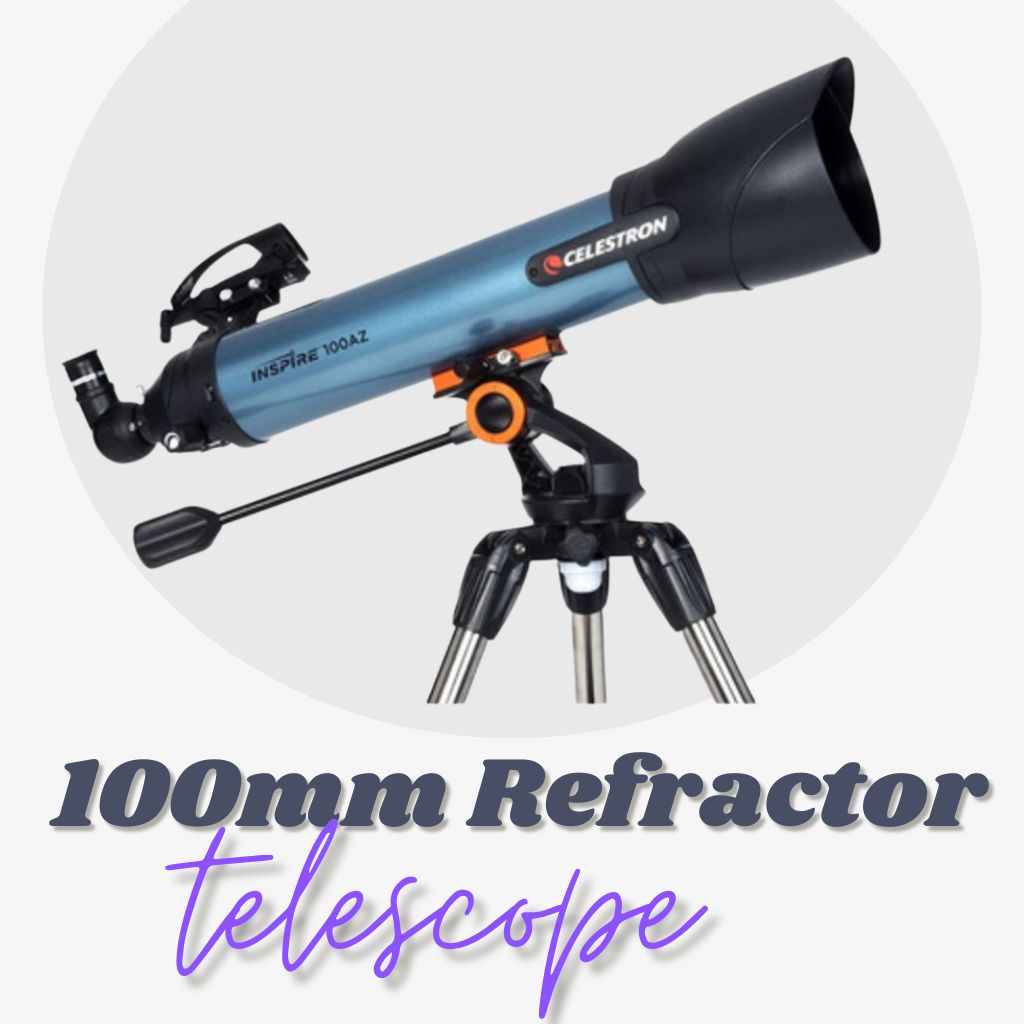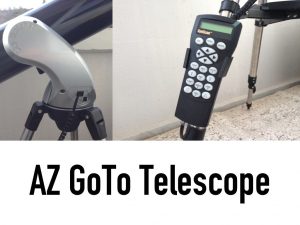This site contains affiliate links to products. I may receive a commission for purchases made through these links.
A 100mm refractor telescope is a great tool for exploring the night sky and observing fine details of various celestial objects. From the Moon to the planets and even deep-sky objects like galaxies and star clusters, there’s no shortage of things to see with a 100mm refractor telescope.
With a relatively large aperture, this type of telescope can capture a good amount of light and offer detailed views of objects in the night sky.
In this article, we will discuss in detail the various objects you can observe using this type of telescope.
What to see with a 100mm refractor telescope
Here are some of the objects you can observe with a 100mm refractor telescope:
The Moon
With a 100mm refractor telescope, there is much to observe on the Moon. The telescope can provide a detailed view of the different features and terrain present on the Moon, such as craters, mountains, and the Maria.
The craters on the Moon are visible due to the shadows created by the sun’s angle and can provide an insight into the lunar history.
The mountains, which can reach heights of up to 5 kilometers, are another fascinating feature to observe.
You may also like: 14 Best Telescopes to See the Moon
Planets
A 100mm refractor telescope can provide views of several planets in our solar system.
Here are the planets you can view with this telescope:
Mercury
Observing Mercury with a 100mm refractor telescope can be quite challenging due to its close proximity to the Sun.
However, during favorable conditions, it is possible to see the planet’s phases and surface details.
Venus
Venus is one of the brightest objects in the night sky and is easily visible through a 100mm refractor telescope.
You can see its phases, thick atmosphere, and even the occasional transit across the face of the Sun.
Mars
Mars is a favorite among planetary observers, and a 100mm refractor telescope can provide a clear view of its rusty red surface, polar ice caps, and dust storms.
Jupiter
Jupiter is the largest planet in our solar system and a prominent target for observers. With a 100mm refractor telescope, you can see the planet’s colorful cloud bands, the Great Red Spot, and its four largest moons: Io, Europa, Ganymede, and Callisto.
You may also like: 11 Best Telescopes to See Jupiter (Planet, Red Spot, and Moons)
Saturn
Saturn is known for its beautiful rings, which can be easily seen through a 100mm refractor telescope. You can also see the planet’s subtle cloud bands and its largest moon, Titan.
You may also like: How Big of a Telescope Do You Need to See Saturn’s Rings?
Uranus
Uranus is one of the outer planets and can be seen as a tiny blue-green dot through a 100mm refractor telescope. While its small size and distant location make it difficult to observe any details, it is still a fascinating sight to behold.
Neptune
Like Uranus, Neptune is also located in the outer reaches of our solar system and can be challenging to observe with a 100mm refractor telescope.
However, with good viewing conditions, observers can catch a glimpse of its blue hue and possibly even see its largest moon, Triton.
Read also: What Size Telescope Do I Need to See Neptune?
Deep sky objects
You can view some deep sky objects with a 100mm refractor telescope, although the level of detail and clarity may vary depending on factors such as light pollution and atmospheric conditions.
Some common types of deep sky objects that can be seen with a 100mm refractor telescope are:
Star clusters
Star clusters are groups of stars that are held together by gravity. Some star clusters that can be seen with a 100mm refractor telescope include the Pleiades (open cluster) and M13 (globular cluster).
Nebulae
Nebulae are clouds of gas and dust in space. There are several types of nebulae, including emission nebulae, reflection nebulae, and planetary nebulae.
Some nebulae that can be seen with a 100mm refractor telescope include the Orion Nebula (emission nebula) and the Ring Nebula (planetary nebula).
Galaxies
Galaxies are massive collections of stars, gas, and dust held together by gravity. Some galaxies that can be seen with a 100mm refractor telescope include the Andromeda Galaxy (spiral galaxy) and the Whirlpool Galaxy (spiral galaxy).
You may also like: 9 Best Deep Space Telescopes
Best 100mm refractor telescopes
Let’s take a look at some of the best 100mm refractor telescopes available in the market today:
Sky-Watcher ProED 100mm Doublet APO Refractor Telescope-Best for astrophotography and visual astronomy
The Sky-Watcher ProED 100mm Doublet APO Refractor Telescope is a high-quality telescope designed for the discerning astronomer.
Its 100mm aperture and doublet objective lens provide excellent image quality and resolution, making it ideal for visual observation and astrophotography.
One of the features of the Sky-Watcher ProED 100mm Doublet APO Refractor Telescope is its Apochromatic (APO) lens. This lens type uses extra-low dispersion (ED) glass to eliminate chromatic aberration, resulting in sharp and clear images with accurate color representation.
This means that objects viewed through this telescope will appear much sharper and clearer than with other types of telescopes.
With a focal length of 900mm and a focal ratio of f/9, the Sky-Watcher ProED 100mm Doublet APO Refractor Telescope can provide detailed views of planets, star clusters, galaxies, and more.
It is also suitable for astrophotography, allowing you to capture beautiful images of deep sky objects.
Celestron Inspire 100AZ-Best for astrophotography
The Celestron Inspire 100AZ is a high-quality 100mm f/6.6 Alt-Az refractor telescope that provides exceptional views of celestial objects.
With its 100mm objective lens and fully coated glass optics, this telescope can gather ample amounts of light to deliver clear views of the night sky.
The Celestron Inspire 100AZ features a sturdy and lightweight aluminum frame with an alt-azimuth mount, making it easy to set up and use.
Its manual alt-azimuth mount allows for smooth and precise adjustments, making it easy to track objects in the sky.
The Celestron Inspire 100AZ is perfect for observing the Moon, planets, and brighter deep-sky objects such as star clusters and nebulae.
The telescope’s relatively fast f/6.6 focal ratio also makes it well-suited for astrophotography, especially with a DSLR or mirrorless camera.
Pros of a 100mm refractor telescope
Here are some of the pros of a 100mm refractor telescope:
Excellent image quality
A 100mm refractor telescope provides excellent image quality due to its large aperture and high-quality lenses.
It can capture more light and produce sharp and clear images of celestial objects, including planets, stars, and galaxies.
Portability and ease of use
Compared to other types of telescopes, 100mm refractors are relatively small and lightweight, making them easy to transport and set up.
They also have a simple design and do not require complicated alignment procedures, which makes them easy to use even for beginners.
Durability and low maintenance
100mm refractor telescopes are known for their durability and low maintenance requirements. They have a sturdy construction and do not require regular collimation or cleaning of mirrors, which saves time and effort.
Versatility
A 100mm refractor telescope can be used for various astronomical observations, including planetary viewing, stargazing, and astrophotography. It can also be used for terrestrial observations with the right accessories, such as a star diagonal or a camera adapter.
Cons of a 100mm refractor telescope
Here are some of the limitations of a 100mm refractor telescope:
Limited light-gathering capacity
Compared to larger telescopes, a 100mm refractor telescope has limited light-gathering capacity. This means it is less effective in capturing faint, deep sky objects than larger telescopes with larger apertures.
As a result, the views of dim objects, such as distant galaxies or faint nebulae, may be less impressive.
Limited magnification
Another limitation of a 100mm refractor telescope is its limited magnification.
While it can provide clear views of objects in the solar system and some deep sky objects, it may not be able to provide high magnification views of some objects, such as small planetary details or close-up views of some deep sky objects.
Chromatic aberration
Achromatic refractors, such as 100mm refractor telescopes, may experience chromatic aberration, resulting from different wavelengths of light refracting at slightly different angles.
This can result in color fringing around objects, particularly those that are bright and have high contrast.
While some telescopes come with special coatings or lenses that minimize chromatic aberration, it can still be a limitation for some 100mm refractor telescopes.
High price point
While 100mm refractor telescopes are relatively affordable compared to larger telescopes, they can still be more expensive than other types of telescopes, such as reflectors or catadioptric telescopes.
Some higher-end models of 100mm refractor telescopes can be quite expensive, which may not be suitable for beginners or those on a tight budget.
Is a 100mm refractor telescope worth it?
A 100mm refractor telescope offers a decent aperture size for observing the moon, planets, double stars, and some deep sky objects.
It is also relatively compact and easy to transport, making it a great option for those who need a portable telescope.
However, a 100mm refractor telescope may not be suitable for those who want to observe fainter deep sky-objects such as galaxies and nebulae in detail.
FAQs
Here are the answers to some frequently asked questions:
Can I view Neptune with a 100mm telescope?
You can view Neptune with a small telescope like the 100mm telescope, but it will appear as a small blue dot due to its distance from Earth.
What telescope size is good for seeing planets?
A telescope with an aperture of at least 70mm is recommended for viewing planets. However, a larger aperture, such as 100mm or above, will provide clearer and more detailed views.
You may also like: 21 Best Telescopes to See Planets
What can I see with a 102mm refractor telescope?
With a 102mm refractor telescope, you can see the Moon, planets, double stars, star clusters, and some brighter nebulae and galaxies.
What can I see with a 120mm refractor telescope?
A 120mm refractor telescope can provide clearer and more detailed views of the Moon, planets, and other deep-sky objects such as galaxies and nebulae.
Is an 80mm refractor telescope any good?
An 80mm refractor telescope can provide good views of the Moon, planets, and some deep-sky objects.
However, a large telescope, such as 100mm or above, will provide even better views.
The telescope’s focal length is an important factor to consider when choosing a telescope.
Read more on this here: What Can You See With an 80mm Refractor?
Takeaway: A 100mm refractor telescope can provide nice views of the moon, planets, and some deep-sky objects
A 100mm refractor telescope is a great option for amateur astronomers who want to explore the night sky.
With this telescope, you can see a variety of celestial objects like the Milky Way. The 100mm refractor telescope can also capture large deep sky objects such as the Orion Nebula and Andromeda Galaxy with its moderate aperture.
While only the aperture of a telescope is not enough to guarantee optimal viewing, the 100mm refractor telescope’s size can still deliver impressive results.
Moderate light pollution may limit the visibility of fainter objects, but a 100mm refractor can still provide decent views.
There are some limitations to consider, but the benefits of a 100mm refractor outweigh the cons and make it a worthwhile investment for those interested in stargazing.
You may also like:







